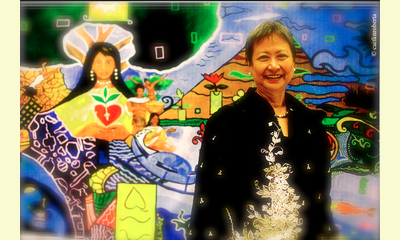|
|
Interview with Ms. Cecile Guidote-Alvarez Director, UNESCO DREAM Center, Philippines
un article par Javier Collado Ruano, Director of Edition at Global Education Magazine (abridged)
In current post, I wanted to share with all readers
of Culture of Peace News Network the interview that
I realized with Ms. Cecile Guidote-Alvarez, Director
at the UNESCO DREAM Center of Philippines.

click on photo to enlarge
The interview was published with motive of
International Women´s Day and we talk about the
Workshop-Forum entitled “the Interdisciplinary
Cultural Roadmap to Healing Trauma and Building
Climate Solutions” which took place a month ago in
Bohol, the area affected by earthquake/Super
Typhoon Haiyan. As Ms. Guidote-Alvarez said “the
forum and workshop was engaged teachers, artists,
social workers, medical practitioners,
policymakers, industry representatives,
scientists, and other stakeholders in a lively
discussion and demostration of the realistic
options at hand for restoring and nurturing the
mental health of survivors with skills training
for employment or entrepreneurship while
engendering fortitude, faith and the strength of
spirit to triumph over adversity”.
At the interview, we also dialogue about the role of
the UNESCO-Jakarta, Regional Science Bureau for Asia
and the Pacific in such practices at the events.
Without doubts, these efforts will go a long way
as community members become more aware of the
phenomenon of climate change, especially for the
natural disasters. In this sense, I totally agree
with Dr. Irina Bokova, Director-General of UNESCO,
when she expressed to you in the letter of
19th December 2013 that “the expedition of the
Ensemble to Paris would not have been possible
without your personal engagement and energy. Your
presence here in the aftermath of
Typhoon Haiyan was a more timely gesture to honour
the victims of the devastating natural disaster.”
I am sure the initiative Theatre Training for
All of the ITI in the Asia-Pacific region will
represent a big initiative to help all survivors.
On the other hand, we also talked about the
situation of women in the SE Asia region and about
the future horizons of Global Citizenship
Education proposed by UNESCO for the post-2015
development agenda. . .. . I asked her “Why do you
think it is so important that the theatre help
people in general and especially for those who are
now handicapped physically and psychologically?”
And her replied was the following:
“Theatre is a mirror. It calls attention to
problems and provides a multi-sectoral avenue for
an intercultural dialogue to reflect on solutions
and creatively bond groups of common interest to
cooperatively address or prevent crisis. Creative
empowerment with skills and confidence building
coupled with endurance and perseverance is a
prerequisite armor for people who are in a mental
state of discombobulation because of incalculable
grief of loss, anger and despair due to physical
incapacity or deprivation. It is an engine for
creative industry and social entrepreneurship.
Theatre is also an anchor that can help
participants and audience grow in the appreciation
of indigenous heritage and traditional values that
must not be laid aside but reconciled with
technological advances. It is an antidote to
forgetfulness. In fact, a memory bank to draw
lessons from history to guide present and future
action because the worst illness that can be
inflicted on a person or a nation is amnesia and
even Alzheimer’s disease.”
If you want to read more, visit the full article.
|








|
DISCUSSION
Question(s) liée(s) à cet article:
The theatre, How can it contribute to the culture of peace?,
* * * * *
Commentaire le plus récent:
(Pour la version originale en Français, voir ci-dessous)
The actor lives between two worlds, one of which is his proper existence and the other, the world of fiction where he takes on the role of his character. He seems to have one foot on each of them while his head collects, combines, mixes, synthesizes and puts together the emotions that are translated and expressed by body and voice.
We get it directly, it is "in our face" with no escape possible! The richness of this mixture "reality/fiction" allows the artist to enter into us through hidden doors.
Using texts with humor and irony, the actor passes messages to which our minds would otherwise be deaf! He affects us, challenges us, plays with us, provokes us, making our attention an accomplice of what he has to say.
The direct contact and proximity, sometimes intimate, between stage and audience send us messages that we hear, questions that provoke us to transferring images to our daily experience, our reality, to "real life"!
Thus we are pushed and shaken from calm to storm, from injustice to anger, from hatred to solidarity, from indifference to empathy in the face of violence.
Actors are in the public service. They are "Public Friends Number One!" They are chroniclers, "troublemakers," breakers of habit, forcing us to think things through.
The culture of peace needs the oxygen of this youthful spirit! , I believe that art in general, with its playfulness, has the power to awaken us. It is an excellent support to the promotion of the Culture of Peace.
I love the theater, it is a space of freedom where actors can transmit an energy drawn from the conviction of what they say. . ... continuation.

|
|









